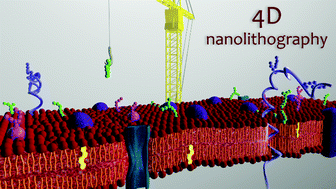Towards scanning probe lithography-based 4D nanoprinting by advancing surface chemistry, nanopatterning strategies, and characterization protocols
Abstract
Biointerfaces direct some of the most complex biological events, including cell differentiation, hierarchical organization, and disease progression, or are responsible for the remarkable optical, electronic, and biological behavior of natural materials. Chemical information encoded within the 4D nanostructure of biointerfaces – comprised of the three Cartesian coordinates (x, y, z), and chemical composition of each molecule within a given volume – dominates their interfacial properties. As such, there is a strong interest in creating printing platforms that can emulate the 4D nanostructure – including both the chemical composition and architectural complexity – of biointerfaces. Current nanolithography technologies are unable to recreate 4D nanostructures with the chemical or architectural complexity of their biological counterparts because of their inability to position organic molecules in three dimensions and with sub-1 micrometer resolution. Achieving this level of control over the interfacial structure requires transformational advances in three complementary research disciplines: (1) the scope of organic reactions that can be successfully carried out on surfaces must be increased, (2) lithography tools are needed that are capable of positioning soft organic and biologically active materials with sub-1 micrometer resolution over feature diameter, feature-to-feature spacing, and height, and (3) new techniques for characterizing the 4D structure of interfaces should be developed and validated. This review will discuss recent advances in these three areas, and how their convergence is leading to a revolution in 4D nanomanufacturing.

- This article is part of the themed collection: 2016 Emerging Investigators


 Please wait while we load your content...
Please wait while we load your content...